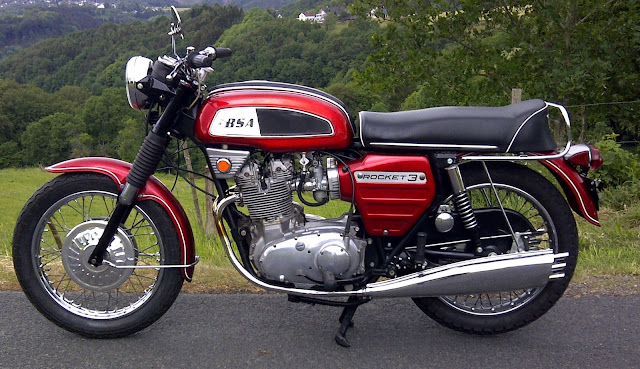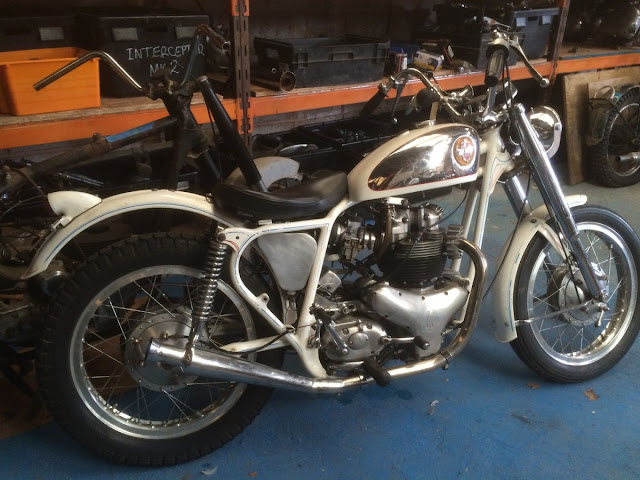BSA Road Rocket 650
The Road Rocket's handling might not have been outstanding, but the hard-accelerating twin went round corners well enough to be competitive with its twin-cylinder rivals.
Slim styling in the BSA tradition gave the Road Rocket good looks to match its aggressive performance. The 646cc engine’s tuning parts ' included aluminium cylinder head, hot cam and high compression pistons.
On its introduction in 1954, the 650cc Road Rocket was the fastest and best bike that BSA had ever built. More to the point, it was quick and stylish enough not only to become a hit in the big American market for which it had essentially been developed, but also to boost the image of the giant Birmingham factory, whose existing twin-cylinder 650, the A10 Golden Flash, was competent but not very exciting.
The Road Rocket was a distinctly sportier machine than the Flash. As Motor Cycling magazine commented when the model was introduced to the home market in 1956, the Road Rocket was a roadgoing solo ‘with just that little bit extra in the way of speed and specification luxury . It was well suited to an American market that traditionally demanded style, capacity and performance from its motorcycles.
In 1954, BSA was in the process of introducing a new twin-shock frame for the Golden Flash, as a replacement for the old design with plunger rear suspension. The Road Rocket used the new chassis to hold an engine based on that of the short-lived A10 Super Flash, BSA’s first sports 650cc model, which had been sold almost exclusively in the States the previous year.
The 646cc parallel twin unit was tuned with an aluminium cylinder head, uprated exhaust valves, Arnal TT9 carburettor, hotter camshaft, toughened heavy-duty crankshaft, and high-compression pistons. It also had a manual advance-retard lever for adjusting the ignition, something that was not deemed necessary on the more softly tuned Golden Flash. Peak power rose to 40bhp at 6000rpm.
Home market Road Rockets were fitted with flatter handlebars and more efficient silencers than the original export machines. They were otherwise identical to the American market bikes, complete with red paintwork plus the partially chromed fuel tanks that had become a BSA trademark.
Brisk acceleration
Low-speed acceleration was very brisk, and despite its relatively high state of tune, the Road Rocket s twin-cylinder engine had plenty of low-down torque and a very docile nature. As The Motor Cycle magazine noted in its test of March 1957, the standard Golden Flash was well known for its wide spread of torque, but ‘the trait seems to have been enhanced rather than impaired on the tuned engine. In practice this means that really lusty acceleration and power reserve for gradients, head winds and passenger carrying are available over a broad engine-speed range.’
More to the point, the Rocket was fast. BSA claimed a top speed of 105mph (169km/h), and the bike was timed at exactly that speed during one magazine’s testing, despite a cross-wind. Triumph s rival hot 650, the Tiger 110, was arguably faster still, but only by the slimmest of margins. Equally importantly, the Road Rocket could be cruised 'without signs of fatigue’ at between 95 and 1 OOmph (153-161km/h), according to one contemporary test.
The Road Rocket’s speed and good looks, along with its dependable handling, earned it many admirers. Its motor proved impressively reliable, too. Its only mechanical weakness was in the area at the bottom of the cylinder block, which could give problems when the high-compression motor was revved hard.
The Road Rocket sold well in the States but, after being introduced to the home market midway through 1956, two years late, it lasted in production barely more than a year before being replaced by the Super Rocket, which was a very similar bike but which had slightly higher compression ratio, redesigned cylinder head, Amal Monobloc carburettor, and a headlamp nacelle. The Road Rocket was no more, but it had succeeded in proving that BSA was capable of producing a fast and exciting 650cc twin.
The Road Rocket name and tank logo helped to emphasize the BSA’s scorching performance. Not that this bike's rider needed much reminding, once the throttle was wound open...
Chromed tank sides looked good when combined with the BSA’s red paintwork. The Road Rocket model’s mudguards were originally also chromed; this restored bike’s red finish was introduced with the Super Rocket in 1958.
Specification BSA Road Rocket (1956)
- Engine Air-cooled ohv pushrod four-valve parallel twin
- Capacity 646cc (70 x 84mm)
- Maximum power 40bhp @ 6000rpm
- Transmission Four-speed, chain final drive
- Frame Steel twin downtube
- Suspension Telescopic front; twin shocks rear
- Brakes Drum front and rear
- Weight 4181b (190kg)
- Top speed 105mph (169km/h)

















0 comments: